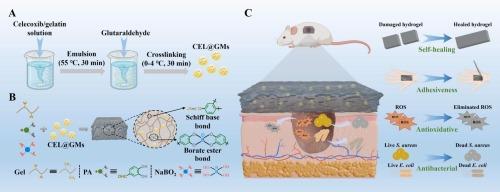Microsphere-embedded gelatin-based hydrogel with self-healing, hemostatic, antioxidative, and antibacterial activity for wound healing
IF 6
2区 医学
Q2 MATERIALS SCIENCE, BIOMATERIALS
Materials Science & Engineering C-Materials for Biological Applications
Pub Date : 2025-09-19
DOI:10.1016/j.bioadv.2025.214516
引用次数: 0
Abstract
Excessive reactive oxygen species (ROS), bacterial infection and intense inflammation constitute key complications that hinder wound healing. Hydrogels have shown promising applications in wound management due to their high biocompatibility and adjustable functionality. However, the poor mechanical and self-healing properties of conventional hydrogel dressings can't meet the multifaceted demands of motion wounds. To address these issues, we designed and constructed a series of multifunctional microsphere-embedded gelatin-based dual-dynamic-bond cross-linked hydrogels (GPB hydrogels) via the formation of Schiff base bonds and borate ester bonds. These GPB hydrogels exhibited excellent self-healing and adhesive properties, and they also possessed good biocompatibility and certain hemostatic effects. Moreover, biological activity tests proved that the hydrogel owned excellent antibacterial and antioxidant activities and could reduce inflammatory responses. More importantly, the GPB hydrogels can effectively promote wound healing by accelerating the re-epithelialization and increasing collagen deposition, which showed great potential in the field of hydrogel wound dressings.

微球嵌入明胶为基础的水凝胶具有自我愈合,止血,抗氧化和抗菌活性的伤口愈合
过多的活性氧(ROS)、细菌感染和剧烈炎症是阻碍伤口愈合的主要并发症。由于其高生物相容性和可调节的功能,水凝胶在伤口管理中显示出很好的应用前景。然而,传统水凝胶敷料的力学性能和自愈性能较差,不能满足运动创面的多方面需求。为了解决这些问题,我们设计并构建了一系列基于微球嵌入明胶的多功能双动态键交联水凝胶(GPB),通过形成希夫碱键和硼酸酯键。这些GPB水凝胶具有良好的自愈和粘附性能,具有良好的生物相容性和一定的止血作用。生物活性试验证明,该水凝胶具有良好的抗菌和抗氧化活性,可减轻炎症反应。更重要的是,GPB水凝胶可以通过加速伤口再上皮化和增加胶原沉积,有效促进伤口愈合,在水凝胶伤口敷料领域显示出巨大的潜力。
本文章由计算机程序翻译,如有差异,请以英文原文为准。
求助全文
约1分钟内获得全文
求助全文
来源期刊
CiteScore
17.80
自引率
0.00%
发文量
501
审稿时长
27 days
期刊介绍:
Biomaterials Advances, previously known as Materials Science and Engineering: C-Materials for Biological Applications (P-ISSN: 0928-4931, E-ISSN: 1873-0191). Includes topics at the interface of the biomedical sciences and materials engineering. These topics include:
• Bioinspired and biomimetic materials for medical applications
• Materials of biological origin for medical applications
• Materials for "active" medical applications
• Self-assembling and self-healing materials for medical applications
• "Smart" (i.e., stimulus-response) materials for medical applications
• Ceramic, metallic, polymeric, and composite materials for medical applications
• Materials for in vivo sensing
• Materials for in vivo imaging
• Materials for delivery of pharmacologic agents and vaccines
• Novel approaches for characterizing and modeling materials for medical applications
Manuscripts on biological topics without a materials science component, or manuscripts on materials science without biological applications, will not be considered for publication in Materials Science and Engineering C. New submissions are first assessed for language, scope and originality (plagiarism check) and can be desk rejected before review if they need English language improvements, are out of scope or present excessive duplication with published sources.
Biomaterials Advances sits within Elsevier''s biomaterials science portfolio alongside Biomaterials, Materials Today Bio and Biomaterials and Biosystems. As part of the broader Materials Today family, Biomaterials Advances offers authors rigorous peer review, rapid decisions, and high visibility. We look forward to receiving your submissions!

 求助内容:
求助内容: 应助结果提醒方式:
应助结果提醒方式:


